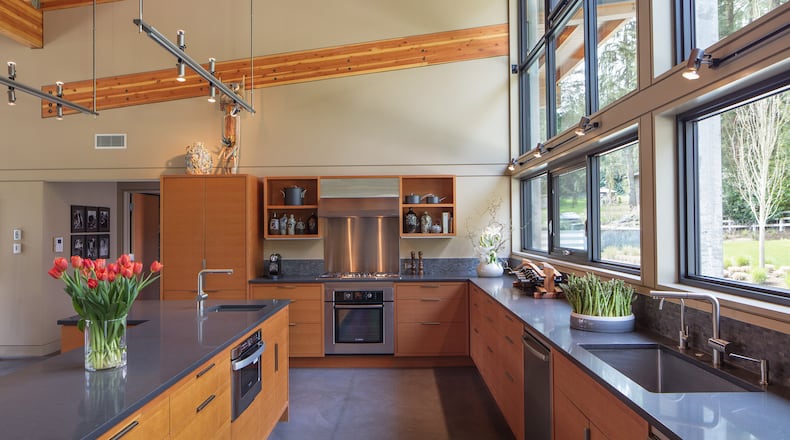CHAPTER ONE: THE SHOW ME YARD
“I grew up in Missouri, where most of the lots are acreage,” Fisher says. “I always played in yards as a child. Coming here to Bellevue, I still always had that idea of acreage, and Bridle Trails was one of two or three places with suitable property.”
Here, on a slightly sloping corner, he found a supremely suitable, almost-acre lot — roomy enough for its previous single-story home, horse pasture and four-stall barn — but, you might have noticed, “equestrian” is not among Fisher’s defining characteristics.
Enter Stephen Bobbitt, the architect of refined definitions.
“(Fisher) envisioned a home that would … provide a strong link to what he considers a quintessential element of his image of home: a spacious, lush, green lawn,” Bobbitt says.
Home, then, is where the yard is. And now, from every angle, Fisher’s new Northwest contemporary home strikes a long, low profile on ample waves of green.
“The program started itself out this way: Take advantage of the lawn,” Bobbitt says. “So it’s stretching on a north-south axis, giving every major room a view of the lawn, public and private.”
CHAPTER TWO: HI, TECH
Walls of glass blur the boundaries between inside and out, but the public/private distinction is deliberately more defined. There are three separate but clearly connected pavilions: the wide-open great room; the bedroom pavilion, with a master suite, two guest suites and home office; and support spaces such as the laundry, mudroom — and one room that is especially pivotal, and private.
“Early on, he stated that the computer-server room was the most important space,” Bobbitt says. “It’s the heart of the house.”
Vinyl sheeting drapes Fisher’s technical equipment, all highly organized and intentionally centralized.
“I don’t like a jungle of cables,” he says. “Rather than spread it through the house, I put it all in one place. It’s very easy.”
It’s also very, very chill.
“It’s meant to be this cold,” Fisher says. “The room also has a second purpose: It was built for a wine cellar, normally about 65 degrees.”
CHAPTER THREE: A HOST OF OPTIONS
Fisher turns into a server himself in the gorgeous, open kitchen, one of two purposeful, public entertaining spaces where work meets play.
“When I look at the kitchen design, my engineer side kicks in,” Fisher says. “Thirty people here; how are things moving?”
The 22-foot-long kitchen island, of super-durable, antique heart pine, takes center stage as the main buffet area, for both prepping and dishing up. Bonus buffet line: the 60-inch round table, stretchable with lovely leaves.
Two dishwashers flank the sink, bringing balance but no rude interruptions (“They’re quiet enough to run while people are talking,” Fisher says). All the appliances are waist-level or below, with plates and bowls hanging in nearby drawers and wineglasses dangling there upside-down. “The dishwashers are at the same level as where the dishes go,” he says. “It’s wonderful for entertaining.”
Also conveniently close: a film buff’s home theater, just off the great room, isolated but connected. “It’s a very important room,” Bobbitt says.
“It looks very simple, but it’s so complicated,” Fisher says. “Everything here was put in a particular way.”
Customized, motorized, plush recliners optimize the theater experience. Acoustic fabric forms a false wall; speakers hide inside, with two back channels in the ceiling. Equipment is tucked out of sight, and a custom table (which doubles as another buffet) offers a sightline over other guests’ heads. Kids can lie on, and roll away, a bench in front. And carefully curated posters of American movies with Japanese text “tie into the Asian theme in the house but communicate, ‘This is a theater,’ ” Fisher says.
CHAPTER FOUR: BRINGING THE WORLD HOME
Continuing the theme, interior designer Jennifer Randall “brought in blues and indigo as accents” in a nod to “Lon’s love and passion for Japanese things,” she says.
In the kitchen, modular cabinetry repeats “detailed, subtle rhythms,” Bobbitt says, and the only two upper cabinets display eight sake bottles that Fisher discovered at Glenn Richards & Honeychurch Antiques. “That ended up a fortuitous find, given the Asian theme,” Fisher says.
Outside, frosted-glass garage doors “subtly reinforce the Asian theme,” Bobbitt says — and then, like everything, it all comes back to the yard.
On its northern edge, a small grove of Japanese cherry trees was planted as “a reminder of and reflection on (Fisher’s) travels in the Far East,” Bobbitt says.
Out here, from the lush lawn that says home, Fisher says, “I still look up at this and think, ‘Wow; that’s cool.’”
About the Author
